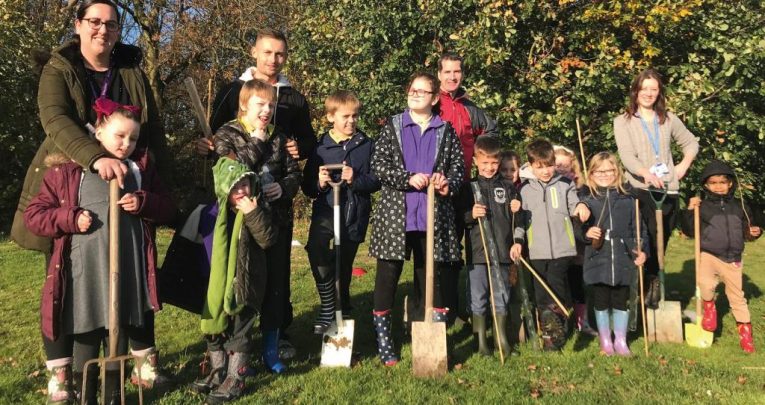Lessons from an ‘SEN School of the Year’

We take a closer look at what the practice followed by a ‘SEN School of the Year’ looks like in action…

Clive Lawrence became one of the youngest headteachers in the country when, just a few days short of his 28th birthday in 2014, he assumed his first headship at a community special school in Staffordshire.
Derby born and bred, Lawrence is now executive headteacher at St Giles School. It’s the city’s only special primary school – one rated Outstanding by Ofsted – and is currently preparing to join the Spencer Academy Trust.
“This collaboration will allow skills, knowledge and expertise to be shared across the Trust,” Lawrence says.
“There are very few Academy structures like this, which will enable us to set the blueprint for creating aspirational opportunities for all children, regardless of needs and background.”
A voice for all
Lawrence is keen to emphasise the contributions of the team that works alongside him in St Giles’ recent success: “I’m fortunate to have a hard-working and committed team here, who go above and beyond to create an amazing environment for the children. Despite the complex needs of our pupils, we try our best to ensure that all of them are able to make substantial and sustained progress across the curriculum. We want them to thrive and be the best they can be.”
Twelve months ago, St Giles became an Inclusive Teaching School Alliance with staff providing a range of communication training to both mainstream and special school settings in the area, upskilling their practitioners to support children with SEND and SLCN.
Practitioners from other schools now regularly visit St Giles as part of their own CPD, spending time in classes and observing lessons, and later implementing what they’ve learned about the school’s communication strategies into their own teaching and learning.
More recently, this work has helped St Giles attain national recognition. It’s been accredited by both the National Autistic Society and the children’s communication charity I CAN, and has earned the Inclusion Quality Mark at top ‘Flagship School’ level.
In March of this year, St Giles was chosen as the 2019 ‘SEN School of the Year’ at the Shine a Light Awards.
The school’s stated mission is to ‘provide pupils with effective strategies to communicate, promote independence and prepare pupils for life in the local and wider community’.
As Clive Lawrence explains, “Here at St Giles, we do our best to ensure all children have a ‘voice’. Early identification and targeting of all pupils is key at any school, and we work hard to ensure a smooth transition from the child’s previous education establishment to St Giles School.
“Information is collected from those previous settings, and we will chat to parents and carers to achieve a greater understanding of the child, before individualised communication system support plans are put into place, while considering their EHCP targets. The latter can often be difficult, so the school will ensure that parents and children themselves are involved at all times, with school staff giving pupils the motivation and means to communicate their wants and wishes.”
Growing in confidence
One can point to several examples of how this approach has successfully worked in practice. In September 2018, seven-year-old Issac Hogan joined St Giles.
Issac had been diagnosed with attention deficit hyperactivity disorder and autism. Following the death of his father when Issac was just three years old, he also developed selective mutism.
While he had initially attended mainstream school, a series of exclusions for behavioural issues led mum Lisa to believe that there was something more deep-rooted that needed addressing.
“I knew when Issac was just 15 months old that something wasn’t quite right, she says. “I had to keep taking him to see the doctor, and it wasn’t until 2016 that he was diagnosed with ADHD. Seven months later, he was diagnosed with autism, too.
“My instinct told me that it wasn’t just the ‘terrible twos’, that he wasn’t just a ‘naughty boy’. At first, Issac would be excluded from nursery for an afternoon. Then the periods of exclusion would be extended to five days. By December, three months after starting mainstream school, Issac had racked up over five exclusions. It was then that I contacted the Derby-based charity Umbrella, which advised me to get an EHCP for Issac, which ultimately took 10 months.”
Staff at St Giles reassured Lisa that the school was the best place for Issac, who at that time was using a stuffed toy – a monkey he called ‘Monk’ – as a form of communication, holding him in front of his mouth when he needed to speak.
Yet within just six months, staff at St Giles were able to help Issac rely less on Monk and grow in confidence.
Above and beyond
“From the moment we walked through the door, it just felt right for us.” says Lisa. “Issac feels like he ‘belongs’ there. He can be himself and is accepted for who he is – a wonderful, caring little boy who has additional needs.”
Every child at St Giles is assigned a team of staff to assist them when they join. “Issac was placed in a class with a TA call Jakk Capewell, and he’s great,” adds Lisa.
“I believe Clive Lawrence thought that Issac needed a young, male role model in his life following the death of his dad – and Jakk’s perfect for him.”
St Giles staff have even been known to lend pupils support outside of school. “Issac had to go for an eye test a few weeks after starting school and was feeling very anxious about it,” Lisa remembers.
“Jakk came along with us to the appointment, to help him feel more at ease. He didn’t have to do that, and that’s why St Giles is so fantastic. They go above and beyond expectations.”
School and home
St Giles’ inclusive learning opportunities include sensory swimming lessons, horse riding sessions and art therapy, plus a hugely successful Forest School programme held at a nearby mainstream school.
The school has also sought to establish partnerships with local organisations.
Together with the Derby County Community Trust – the charity arm of the championship football club – St Giles has twice taken pupils and three members of staff to the Ungana Academy in Kenya, so that they could experience what life is like for children living in the Rhonda Ward of Nakuru.
The school works closely with parents and carers by holding termly meetings to discuss targets, and by offering support as needed from the school’s communication practitioner and speech and language therapist.
The school’s dedicated family support team, meanwhile, provides family workshop sessions where parents have the opportunity to learn Makaton, discover how to access various forms of visual and technical support, and find out more about the various ways in which they can support their child’s communication needs both within school and at home.
Inclusive outreach
The school’s communication practitioner and SLE is Karen Brownhill, who was previously a winner in the Teaching and Learning Support Staff category at the annual nasen Awards.
One of her latest projects saw her volunteering to teach Makaton to staff at a nearby family-orientated pub, so that they could communicate with a family who have a child with Down syndrome – five-year-old St Giles pupil, Oliver Callis.
The Oaklands pub in Littleover, Derby, is now officially ‘Makaton-friendly’. “This was another great example of St Giles in the community,” adds Clive Lawrence. “For Oliver, it means he can transfer the Makaton skills he’s learned at school directly into the community where he lives.”
Staff at The Oaklands have since returned the favour by using their Makaton skills to perform songs for hundreds of well-wishers and TV crews during a fundraising event for St Giles, which managed to raise over £6,500.











